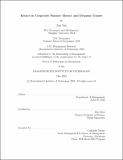| dc.description.abstract | This dissertation consists of three chapters.
In Chapter 1, I study the optimal algorithmic disclosure in a lending market where lenders use a predictive algorithm to mitigate adverse selection. The predictive algorithm is unobservable to borrowers and uses a manipulable borrower feature as input. A regulator maximizes market efficiency by disclosing information about the statistical properties of variables embedded in the predictive algorithm to borrowers. Under the optimal disclosure policy, the posterior belief consists of two disjoint regions in which the borrower feature is more relevant and less relevant in predicting borrower quality, respectively. The optimal disclosure policy differentiates posterior lending market equilibria by the equilibrium data manipulation levels. Equilibria with more data manipulation hurt market efficiency, but also discourage lenders’ use of the borrower feature. Equilibria with less data manipulation benefit from that and generate more efficient market outcomes. Unconditionally, the borrower feature is used less intensively under optimal disclosure.
In Chapter 2, joint work with Mehmet Ekmekci, Leandro Gorno, Lucas Maestri and Dong Wei, we study a dynamic stopping game between a principal and an agent. The agent is privately informed about his type. The principal learns about the agent’s type from a
noisy performance measure, which can be manipulated by the agent via a costly and hidden action. We fully characterize the unique Markov equilibrium of this game. We find that terminations/market crashes are often preceded by a spike in (expected) performance. Our model also predicts that, due to endogenous signal manipulation, too much transparency
can inhibit learning. As the players get arbitrarily patient, the principal elicits no useful information from the observed signal.
In Chapter 3, joint work with Dan Luo, we study SPACs in a continuous-time delegated investment model. The sponsor has an increasing incentive to propose unprofitable projects to the investor over time; in response, the investor exerts more stringent screening based on her information. The screening helps curb the sponsor’s moral hazard, but also dampens the disciplining effect of partial alignment in incentives. When the investor’s information is sufficiently noisy, the second effect dominates, so giving the investor the control over investment approval reduces everyone’s welfare. | |
